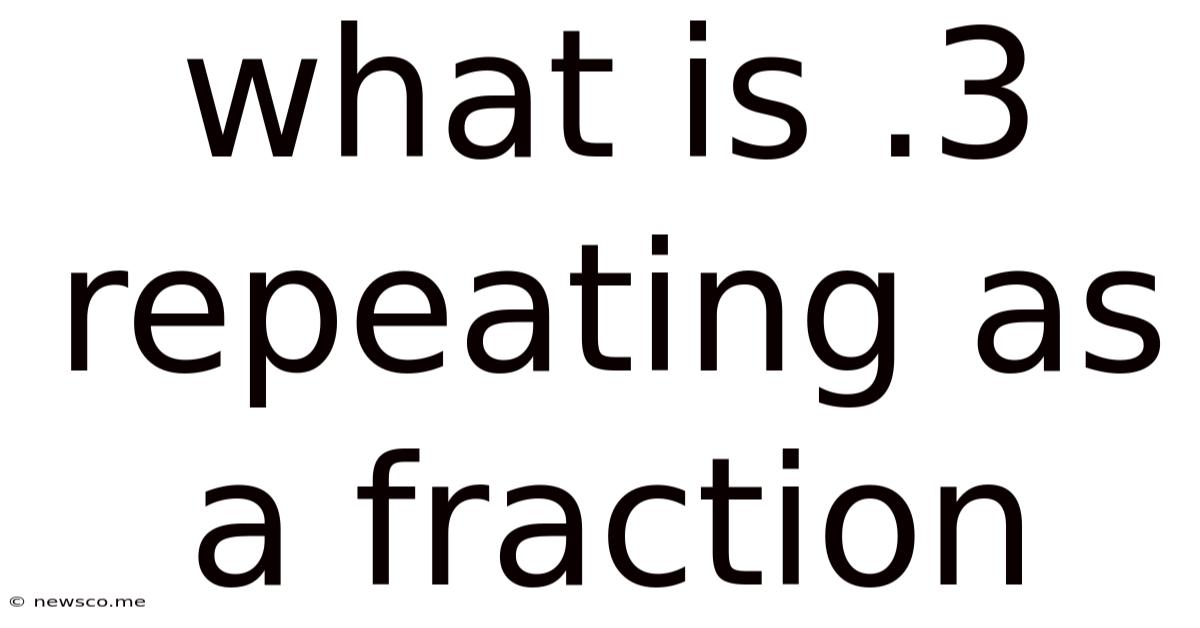What Is .3 Repeating As A Fraction
News Co
Apr 02, 2025 · 5 min read

Table of Contents
What is 0.3 Repeating as a Fraction? A Deep Dive into Decimal-to-Fraction Conversion
The seemingly simple question, "What is 0.3 repeating as a fraction?" opens a door to a fascinating exploration of mathematical concepts relating to decimal representation and fractions. While the answer might appear straightforward at first glance, understanding the underlying principles requires a deeper dive into the mechanics of converting repeating decimals into their fractional equivalents. This article will not only answer the central question but will also equip you with the tools to tackle similar conversions, solidifying your grasp of fundamental mathematical principles.
Understanding Repeating Decimals
Before tackling the conversion, let's clearly define what we mean by "0.3 repeating." This notation, often written as 0.3̅ or 0.$\overline{3}$, signifies that the digit 3 repeats infinitely. It's not 0.33, or 0.333, but an endless string of 3s: 0.333333... extending indefinitely. Understanding this infinite repetition is crucial for the conversion process.
Method 1: The Algebraic Approach – Solving for x
This method elegantly utilizes algebraic manipulation to solve for the fractional representation. Here's how it works:
-
Let x equal the repeating decimal: We begin by assigning a variable, typically 'x', to the repeating decimal:
x = 0.3333... -
Multiply to shift the decimal: Multiply both sides of the equation by a power of 10 that shifts the repeating part of the decimal to the left of the decimal point. Since we have a single repeating digit, we multiply by 10:
10x = 3.3333... -
Subtract the original equation: Subtract the original equation (x = 0.3333...) from the multiplied equation (10x = 3.3333...):
10x - x = 3.3333... - 0.3333... -
Simplify and solve for x: This subtraction neatly cancels out the repeating part:
9x = 3x = 3/9 -
Simplify the fraction: Reduce the fraction to its simplest form by dividing both the numerator and denominator by their greatest common divisor (GCD), which is 3 in this case:
x = 1/3
Therefore, 0.3 repeating is equivalent to 1/3.
Method 2: The Geometric Series Approach – A More Advanced Perspective
This method leverages the concept of an infinite geometric series. An infinite geometric series is a sum of an infinite number of terms where each term is obtained by multiplying the previous term by a constant value (the common ratio). The formula for the sum of an infinite geometric series is:
S = a / (1 - r)
where:
Sis the sum of the series.ais the first term.ris the common ratio (|r| < 1 for the series to converge).
Let's apply this to 0.3 repeating:
-
Express as a series: We can represent 0.3 repeating as the sum of an infinite geometric series:
0.3 + 0.03 + 0.003 + 0.0003 + ... -
Identify a and r: The first term,
a, is 0.3. The common ratio,r, is 0.1 (each subsequent term is multiplied by 0.1). -
Apply the formula: Substitute the values of
aandrinto the formula:S = 0.3 / (1 - 0.1)S = 0.3 / 0.9 -
Simplify: To simplify the fraction, multiply both the numerator and denominator by 10:
S = 3/9 -
Reduce: Reduce the fraction to its simplest form:
S = 1/3
Again, we arrive at the conclusion that 0.3 repeating is equal to 1/3.
Applying the Methods to Other Repeating Decimals
The methods described above are not limited to 0.3 repeating. They are applicable to any repeating decimal. Let's consider a more complex example: 0.142857̅ (where the sequence 142857 repeats infinitely).
Method 1 (Algebraic Approach):
x = 0.142857142857...- Multiply by 1,000,000 (to shift the repeating block):
1000000x = 142857.142857... - Subtract the original equation:
1000000x - x = 142857 - Simplify:
999999x = 142857 - Solve for x:
x = 142857/999999 - Simplify (dividing both numerator and denominator by 142857):
x = 1/7
Method 2 (Geometric Series Approach): This method becomes more complex for longer repeating blocks but remains conceptually similar. You would express the decimal as the sum of an infinite geometric series and apply the formula.
Practical Applications and Real-World Significance
Understanding decimal-to-fraction conversion isn't just an academic exercise. It holds practical value in various fields:
- Engineering and Physics: Accurate calculations often require fractional representations for precise measurements and computations.
- Computer Science: Representing numbers in binary (base-2) often involves converting between decimal and fractional forms.
- Finance: Dealing with percentages, interest rates, and other financial calculations benefits from precise fractional representations.
- Cooking and Baking: Recipes often call for fractional measurements of ingredients.
Common Mistakes to Avoid
When converting repeating decimals to fractions, several common mistakes can lead to incorrect results:
- Incorrect multiplication: Failing to multiply by the correct power of 10 to shift the repeating block.
- Arithmetic errors: Making mistakes during subtraction or simplification.
- Not reducing the fraction: Failing to reduce the fraction to its simplest form.
- Misunderstanding the concept of repeating decimals: Confusing a repeating decimal with a terminating decimal.
Conclusion: Mastering Decimal-to-Fraction Conversions
The ability to convert repeating decimals into fractions is a fundamental skill in mathematics with broad practical applications. By mastering the algebraic approach and understanding the underlying principles of geometric series, you equip yourself with the tools to confidently handle such conversions. Remember to practice diligently, avoid common mistakes, and appreciate the elegance and practicality of these mathematical concepts. The simple question of "What is 0.3 repeating as a fraction?" opens up a world of understanding about the intricate relationship between decimals and fractions, enhancing your mathematical proficiency. The seemingly simple answer, 1/3, belies a rich mathematical underpinning that expands your understanding of numbers and their representation.
Latest Posts
Related Post
Thank you for visiting our website which covers about What Is .3 Repeating As A Fraction . We hope the information provided has been useful to you. Feel free to contact us if you have any questions or need further assistance. See you next time and don't miss to bookmark.